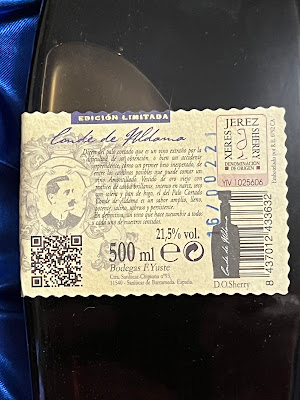This wine was the Bodegas Yuste Conde de Aldama Palo Cortado Sherry, and its fascinating history extends back to the early 18th century, when the solera system first started to be used by the Sherry industry. The bodegas of Aguilar y Cia were established in 1740 in Sanlúcar, and the solera that would eventually result in the Yuste Palo Cortado was founded sometime between 1740-1750. Just take a moment to consider the age of this Sherry when it was born, before even the U.S. acquired its independence, and maybe during King George's War.
We then consider the family of León Aldama y Respaldiza, which came to Sanlúcar from the province of Álava, part of the Basque region. In 1823, León took possession of the bodegas of Aguilar y Cia, acquiring their old barrels of Sherry. His family became quite famed in Sanlúcar, especially for their vast vineyards and fine wines. When León died in 1863, his two nephews, Pedro Aldama Gaviña and José Gabriel Aldama Camba, became his primary heirs. Eventually, José became the first Conde de Aldama ("Count of Aldama") and seems to have taken primary control of the family's wine holdings and production.
During the 1880s, the dreaded phylloxera came to the Jerez region, destroying numerous vineyards and causing a number of bodegas to close. José lost some of his valuable vineyards and though American rootstock was used to save Spanish vines, José found fault with these new vines. He didn't care for the wine made from the new grapes and refused to add the wine to nearly all of his soleras, except for a few test cases. He basically stopped producing any further wine, and only purchased pre-phylloxera wine to add to his established soleras. Around 1888, José finally decided to seal at least some of this oldest soleras, such as those acquired from Aguilar y Cia, behind plaster, allegedly to protect their value and prevent them from being adulterated with wine from new grafted vines.
When José passed away, his nephew, Antonio Aldama Mendivil, the Marqués de Ayala, acquired the estate. Antonio took well to the Sherry business, acting as an almacenista for a number of other companies, and he also invested in other business, from mining to banking. The old soleras, hidden behind the plaster, remained untouched. Eventually, around 1921, there were significant changes and Antonio's financial situation came down crashing as he had started paying insufficient attention to his businesses, being distracted by other matters such as his philanthropy.
Due to his bankruptcy, Antonio was forced to sell off most of his businesses and investments. It then appears that in 1927, the old solera from Aguilar y Cia that had been hidden behind plaster was finally unearthed and then sold to Manuel Argueso Hortal, a wine company that no longer exists. Even under that new ownership, the solera remained essentially untouched, eventually being sold to Valdespino and then later being acquired, with a winery, by a property developer.
Bodegas Yuste was founded by Francisco "Paso" Yuste Brioso, and in 1991, he purchased the historic Bodega Santa Ana in Sanlúcar, and then in 1998, he bought the Viña La Alamedilla, 46 hectares of vineyards in the Jerez pago Carrascal. Around 2001, the property developer who acquired the old solera and winery from Valdespino sold it all to Bodegas Yuste, which took the materials to reconstruct the Bodega Los Ángeles, located in Sanlúcar. This became the home for the ancient solera begun so long ago by Aguilar y Cia.
To this point, the only wine that entered the solera was a small amount to compensate for natural evaporation. Bodegas Yuste later chose to bottle two Sherries from this solera, an Amontillado and, due to some barrel variation, a Palo Cortado. The average age of these Sherries is estimated at 130-150 years old. It could even be older than that.
I've previously enjoyed the Bodegas Yuste Conde de Aldama Amontillado Sherry, which I called "perfection in a bottle." Would the Palo Cortado live up to the experience of the Amontillado? A Palo Cortado is a rare type of Sherry, somewhat a cross between Amontillado and Oloroso. I had high hopes for this Sherry, and it didn't let me down in the least.
I have to begin noting that words are truly inadequate to depict the totality of drinking this extremely old Palo Cortado. However, I will try to encapsulate some of its wonders. First, it possessed a fine, dark amber color. Second, the nose possessed a complex and intense melange of harmonious aromas that seduced and tantalized me. I could identify some of the notes, but others were more elusive, exotic hints of rare aromas. Third, my palate was overwhelmed with pleasure, such an incredible taste. Complexity and harmony, pure elegance and balance. There was even a measure of freshness to this sherry, which is amazing considering its great age. It also possessed a diverse melange of flavors, both familiar and not, including briny notes, almonds, caramel, dried figs, subtle citrus, and much more. An extremely long and pleasing finish. I never wanted to stop drinking this Sherry and it possessed everything I might desire in such a wine. I consumed this wine with some Italian cuisine, and it worked very well, especially with a veal dish topped by black truffles.
I purchased this Sherry back in 2020, and only paid $120 for the 500ml bottle. I think that was an amazing value for such an old and unique wine, especially one which was pure magic to drink. Sherry is too often under-appreciated so you can sometimes find some amazing values. You would be hard pressed to find another type of wine, of a similar age, at close to this price point. However, it may now be difficult to find this wine anywhere, and I have been looking. Fortunately, I bought multiple bottles of this Palo Cortado, so I still have a few in my cellar for a future celebration.



No comments:
Post a Comment